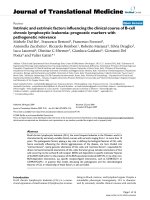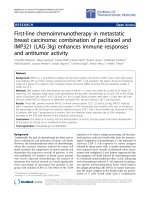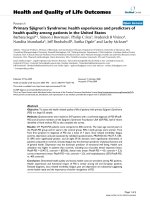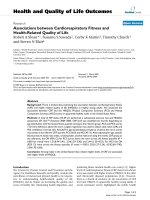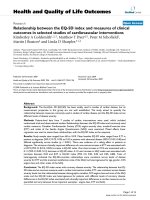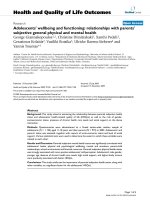báo cáo hóa học: " Different gait tasks distinguish immediate vs. long-term effects of concussion on balance control" ppt
Bạn đang xem bản rút gọn của tài liệu. Xem và tải ngay bản đầy đủ của tài liệu tại đây (211.24 KB, 7 trang )
BioMed Central
Page 1 of 7
(page number not for citation purposes)
Journal of NeuroEngineering and
Rehabilitation
Open Access
Research
Different gait tasks distinguish immediate vs. long-term effects of
concussion on balance control
Robert D Catena, Paul van Donkelaar and Li-Shan Chou*
Address: Motion Analysis Laboratory, Department of Human Physiology, University of Oregon, Eugene, Oregon 97403-1240, USA
Email: Robert D Catena - ; Paul van Donkelaar - ; Li-Shan Chou* -
* Corresponding author
Abstract
The purpose of this study was to longitudinally compare the sensitivity of previously documented
paradigms for measuring balance control during gait following a concussion. We hypothesized that
gait with a concurrent cognitive task would be most sensitive to the effects of concussion on
dynamic balance control. Individuals with concussion (n = 30) and matched controls (n = 30)
performed a single task of level walking, attention divided walking, and an obstacle-crossing task at
two heights. Testing occurred four times post-injury. Balance control during gait was assessed with
whole-body center of mass and center of pressure motion. The single-task level walking task did
not result in any significant differences in balance control between individuals with concussion and
control subjects. Within 48 hours post-injury, individuals with concussion walked slower and
allowed less motion of their center of mass in the sagittal plane when attention was divided during
walking, but there were no group differences by day 6 for this task. Group differences in balance
control during obstacle crossing was unremarkable during the first two testing sessions, but by day
14 individuals with concussion displayed less mediolateral motion of their center of mass. Attention
divided gait is able to better distinguish gait adaptations immediately following a concussion, but
obstacle crossing can be used further along in the recovery process to detect new gait adaptations.
Background
Although concussive incidents rarely result in any patient-
reported long-term symptoms [1], studies have found that
symptoms may last longer than that reported by the
patient; even long after a return to normal unrestricted
activities [2-4]. Although the specific causes of repeated
concussions is unclear, it is our contention that one con-
tributing factor may be related to the well documented [2-
5] long-term deficits in dynamic motor function, such as
balance control during walking. The rate of concussion
has been shown to increase within several months after
the first concussion [6] and multiple concussions occur-
ring with unresolved symptoms can lead to permanent
brain damage or increased probability of fatality depend-
ing on the time interval between concussive episodes [7].
Neuropsychological testing following concussion has
been well documented and is routinely performed at least
in the sports setting [8,9]. Symptoms measured with neu-
ropsychological tests are often reported normal after 14
days post-injury. However, findings of motor dysfunction,
gait imbalance and attentional deficits during motor/cog-
nitive dual-task tests have contradicted this quick (within
two weeks) return to normal functioning. A group of pre-
dominately mild traumatic brain injury (mTBI) subjects
were reported displaying deficits in finger tapping up to a
Published: 7 July 2009
Journal of NeuroEngineering and Rehabilitation 2009, 6:25 doi:10.1186/1743-0003-6-25
Received: 30 April 2008
Accepted: 7 July 2009
This article is available from: />© 2009 Catena et al; licensee BioMed Central Ltd.
This is an Open Access article distributed under the terms of the Creative Commons Attribution License ( />),
which permits unrestricted use, distribution, and reproduction in any medium, provided the original work is properly cited.
Journal of NeuroEngineering and Rehabilitation 2009, 6:25 />Page 2 of 7
(page number not for citation purposes)
year post-injury [3]. Children with mTBI displayed bal-
ance deficits up to 12 weeks post-injury [4]. Severe TBI
subjects have shown balance control deficits while per-
forming obstacle crossing approximately a year after
injury [5]. College-aged adults with concussion showed
decreased dynamic balance control during an attention
dividing task a month post-injury [2].
Recently, tests of balance control during an attention
dividing task have been proposed as an alternative
method for assessing college-aged individuals following
concussion [10,11]. When compared to other gait scenar-
ios, gait with a secondary question and answer task was
found to better differentiate changes in balance control
between patient and control populations within two days
post-injury. While obstacle crossing was deemed ineffec-
tive in distinguishing individuals with concussion imme-
diately following concussion in the same study [10],
others have previously used obstacle crossing tasks to suc-
cessfully detect balance control deficit in more severely
injured subjects months after the injury [5,12].
To our knowledge, a longitudinal examination of balance
control comparing two balance perturbing gait tasks
(divided attention walking vs. obstacle crossing) has not
been performed with individuals suffering from concus-
sion. Such information would uncover dynamic balance
deficits following concussion during both tasks, while
simultaneously identifying the most sensitive test to such
balance deficits. If deficits do exist and tests for such defi-
cits are clinically implemented then patients with concus-
sion may have a more exact timeframe to limit motor
activities and avoid subsequent concussion.
The purpose of this study was to examine dynamic bal-
ance control over a one month period, using gait proto-
cols that have been previously reported separately, to
determine a gait scenario that can effectively detect
changes in balance control of individuals with concussion
and can be used to track recovery. We hypothesized that a
concurrent cognitive task would most effectively accom-
plish both of these purposes based on previous reports.
Methods
Subjects
Thirty subjects with concussion (mTBI) were referred to
testing by the student health center or athletic team physi-
cians/trainers of the university campus. MTBIs (14
females/16 males; age = 21.5 ± 3.3 years; mass = 83.2 ±
24.7 kg; height = 176.7 ± 10.8 cm) were diagnosed with
grade II concussions as defined by the American Academy
of Neurology Practice Parameters [13], which entails
symptoms lasting longer than fifteen minutes, but no loss
of consciousness. Exclusion criteria included preexisting
abnormalities in gait or cognition. Sixteen mTBI partici-
pants had a previous concussion a year or more prior to
testing but none indicated any lingering symptoms. Sub-
jects in this study ranged from non-athletic to intercollegi-
ate athletes and all were still participating in their
particular activity at the time of injury at either the college
or professional level, or have since graduated and are no
longer active.
Thirty control subjects were matched by gender, age (21.7
± 3.1 years), mass (82.6 ± 23.9 kg), height (175.9 ± 10.4
cm), level of education and athletic participation. Exclu-
sion criteria were the same as that for mTBI subjects, in
addition to exhibiting common symptoms of concussion
described by Collins et al [14]. Ten controls had a previ-
ous concussion more than 1.5 years prior to this study,
but none complained of any lingering effects and were
functioning normally in society and academics. There was
no statistical significance in balance measures between
control individuals that did and did not have a previous
concussion (greatest p = 0.460). Approval for the use of
human subjects was granted prior to testing by the univer-
sity Institutional Review Board. Written and verbal
instructions of testing procedures were provided, and
written consent was obtained from each subject prior to
testing.
Apparatus
Twenty-nine retroreflective markers were attached to ana-
tomical landmarks [15]. Three dimensional marker trajec-
tories were collected with an eight camera motion
tracking system (MotionAnalysis Corp.) at 60 Hz. The
cameras were positioned surrounding an eight-meter
walkway. Ground reaction forces and moments were col-
lected at 960 Hz with two in-ground force plates
(Advanced Mechanical Technologies Inc.). A PVC pipe (1/
2" diameter, 1.3 m length) set atop two adjustable
uprights between the two force plates was used as an
obstacle.
Protocol
The first testing (day 2) for mTBI subjects occurred within
48 hours post-injury (35.8 ± 13.1 hours). Data collection
started with a single-task level walking session (LEVEL).
Subjects were asked to walk at a comfortable self-selected
pace while barefoot. Several practice trials were allowed so
that subjects could become accustomed to walking with
the marker set.
Shorter and taller obstacle crossings were then performed
in two blocks. During short obstacle crossing (OBS) the
obstacle was set to a 4 cm height. During tall obstacle
crossing (OBT) the obstacle was set at 10% of the subject's
body height. The final trial block was a divided attention
task (Q&A). Subjects performed unobstructed gait while
continuously responding to a question posed at the begin-
Journal of NeuroEngineering and Rehabilitation 2009, 6:25 />Page 3 of 7
(page number not for citation purposes)
ning of each trial. Questions included: spelling a common
five-letter word in reverse, continuous subtraction by a
certain number, and reciting the months of the year in
reverse order [2,10,11,16,17]. At the beginning of each
trial the subject was given the specific task for that trial
(e.g. count backwards by sevens starting at ninety-three).
The subject then started walking and answering at the
same time and stopped answering at the end of the walk-
way. Each testing session lasted about 30 minutes with
breaks between trial blocks. MTBI subjects performed the
same set of tasks at the approximate 6
th
day, 14
th
day and
28
th
day post-injury. Controls were tested at similar time
intervals.
Data processing
Marker trajectories were filtered with a low-pass fourth
order Butterworth filter at a cutoff frequency of 8 Hz.
Marker position data were used to locate the segmental
center of mass (CoM) of a thirteen-link model including:
head, trunk, two upper arms, two lower arms, pelvis, two
thighs, two shanks, and two feet, based on Dempster's
anthropometric data [18]. A weighted sum method was
used to calculate the whole body CoM during each time
point. CoM motion data were analyzed between the first
heel strike on to the first force plate to the next heel strike
of the same foot. CoM velocities were estimated with the
use of Woltring's generalized cross-validated spline algo-
rithm [19]. Center of pressure (CoP) data were calculated
from force plate data.
A model of how balance is maintained through proper
positioning of the CoM and momentum of the CoM over
the base of support has been established as a measure of
dynamic balance control [20,21]. In this study of walking
balance control, CoM sagittal and coronal plane range of
motion (AP ROM and ML ROM), and peak velocities in
the anterior-posterior (AP V) and mediolateral directions
(ML V) were identified. CoM data were synchronized with
the CoP data to find the maximum horizontal separation
distance between the CoM and CoP in both the sagittal
plane (APmax) and coronal plane (MLmax). Data from
three to five successful trials were averaged together for
each group, day, and task to complete the statistical anal-
yses.
Together the aforementioned variables allow us to exam-
ine two important aspects of dynamic balance control: a
conservative adaptation to walking and the likelihood of
imbalance during walking. Conservative adaptations
include a stride time and step length decrease. These cor-
respondingly reduce AP ROM, AP V and APmax. However,
it is not necessary that these three variables are correlated.
One can alter step length and stride time by varying
amounts up or down, partially independent of each other.
For this reason, we identified each of the AP variables for
conservative adaptations. APmax correlates with a step
length. AP V is a combination of stride length and stride
time without consideration of subject height. AP ROM
correlates with stride length and stride time with consid-
eration of subject height. ML variables demonstrate the
dynamic balance of an individual [5]. Specifically the
MLmax variable corresponds with maximum step width.
ML ROM corresponds with average step width. ML V has
no intuitive relation with other common temporal-dis-
tance variables; however, this can be an important varia-
ble to describe imbalance from side to side [20]. Although
the other variable do have a correlation to temporal-dis-
tance variables, the use of COM variables allows us to
more directly and intuitively measure balance.
Statistical analysis
Although not completely exclusive, the dependent varia-
bles were not analyzed with a MANVOA because they did
not meet linearity criteria. Appropriate assumptions for
mixed ANOVAs were analyzed and considered tenable.
Upon these assumptions being met, a three-way (2
groups, 4 tasks, and 4 days) mixed model analysis with
repeated measures (alpha = 0.05) was conducted using
SAS 9.1 (SAS Institute Inc., Cary, NC). The data were ana-
lyzed following appropriate top-down methods (3-way
interaction, 2-way interactions, main effects). Follow-up
pairwise comparisons with adjustments for multiple com-
parisons were performed when statistical significance was
determined in the mixed model. To account for multiple
comparisons and avoid Type I error, alpha levels were set
a priori at 0.0167 for pairwise comparisons based on rec-
ommendations about error rates relative to individual
family size [22].
Results
The results for sagittal plane balance control clearly indi-
cate that individuals with concussion reduce their forward
motion immediately after injury when having to perform
a divided attention gait task. A three-way interaction in AP
ROM (p = 0.0030) showed that participants with concus-
sion had less sagittal plane CoM displacement than con-
trols on day 2 during the Q&A task (p = 0.0143). A group-
by-day interaction in AP V (p < 0.0001) showed that par-
ticipants with concussion also significantly reduced their
peak anterior CoM velocity on day 2 during the Q&A task
(p = 0.0135; Table 1). APmax also showed a group-by-day
interaction (p = 0.0187), however further analysis only
determined a trend of participants with concussion allow-
ing less separation between their CoM and CoP in the
anterior direction on day 2 during the Q&A task (p =
0.0381). A summary of statistical results is presented in
Table 2.
The results for coronal plane balance control indicate that
individuals with concussion initially are not different
from controls, but they begin to use less coronal plane
motion while crossing an obstacle two weeks after injury.
Journal of NeuroEngineering and Rehabilitation 2009, 6:25 />Page 4 of 7
(page number not for citation purposes)
A three-way interaction in ML V (p = 0.0228) showed that
participants with concussion had significantly slower
sideways peak velocities by day 14 for the shorter obstacle
crossing task (p = 0.0143; Table 1) and by day 28 for the
taller obstacle crossing task (p = 0.0128). A group-by-day
interaction in MLmax (p < 0.0001) showed that mTBIs
also reduced their CoM-CoP separation distance in the
medial/lateral direction by day 28 for both obstacle cross-
ing heights (OBS: p = 0.0006; OBT: p = 0.0018; Table 1).
There were no significant group differences in ML ROM. A
summary of statistical results is presented in Table 2.
Discussion
The purpose of this research was to examine several differ-
ent commonly used gait paradigms to determine which if
any would most effectively distinguish balance control
deficits following a concussion. The statistical analyses
indicated that single task level walking was not able to
effectively distinguish the two groups at any time point in
the recovery process. Previous reports have consistently
demonstrated a tendency for individuals with concussion
to adopt a more conservative gait strategy by either walk-
ing slower and/or allowing less motion of the CoM in the
sagittal plane immediately following the concussion
Table 1: Mean values (standard deviations) of COM variables.
Dependent Variable Task Group Time (days)
261428
AP V(m/s) LEVEL mTBI 1.393 (.141) 1.494 (.152) 1.517 (.152) 1.530 (.152)
Cont. 1.416 (.164) 1.477 (.172) 1.478 (.158) 1.508 (.166)
Q&A mTBI 1.245 (.163) 1.382 (.179) 1.419 (.154) 1.436 (.174)
Cont. 1.326 (.172) 1.405 (.186) 1.428 (.197) 1.445 (.197)
OBS mTBI 1.390 (.145) 1.470 (.157) 1.492 (.146) 1.505 (.154)
Cont. 1.426 (.165) 1.484 (.187) 1.486 (.168) 1.497 (.175)
OBT mTBI 1.342 (.136) 1.435 (.159) 1.453 (.162) 1.458 (.161)
Cont. 1.401 (.177) 1.465 (.183) 1.453 (.167) 1.477 (.183)
MLmax (m) LEVEL mTBI 0.080 (.025) 0.080 (.026) 0.078 (.021) 0.079 (.024)
Cont. 0.076 (.017) 0.079 (.019) 0.078 (.023) 0.084 (.028)
Q&A mTBI 0.084 (.023) 0.082 (.024) 0.081 (.025) 0.077 (.021)
Cont. 0.080 (.022) 0.080 (.019) 0.082 (.019) 0.086 (.028)
OBS mTBI 0.079 (.025) 0.075 (.019) 0.077 (.023) 0.072 (.020)
Cont. 0.076 (.019) 0.076 (.018) 0.084 (.024) 0.087 (.034)
OBT mTBI 0.079 (.025) 0.076 (.023) 0.080 (.032) 0.074 (.022)
Cont. 0.075 (.017) 0.078 (.024) 0.085 (.030) 0.090 (.036)
ML V (m/s) LEVEL mTBI 0.134 (.036) 0.132 (.035) 0.134 (.030) 0.132 (.030)
Cont. 0.133 (.028) 0.140 (.031) 0.138 (.031) 0.135 (.031)
Q&A mTBI 0.148 (.036) 0.148 (.036) 0.145 (.033) 0.145 (.034)
Cont. 0.149 (.032) 0.159 (.032) 0.150 (.030) 0.149 (.038)
OBS mTBI 0.144 (.034) 0.143 (.036) 0.139 (.026) 0.135 (.027)
Cont. 0.146 (.035) 0.151 (.039) 0.157 (.036) 0.148 (.039)
OBT mTBI 0.157 (.029) 0.155 (.038) 0.147 (.029) 0.148 (.029)
Cont. 0.156 (.036) 0.159 (.036) 0.164 (.038) 0.168 (.043)
The two group means in bold are significantly different from each other.
Table 2: P-values from statistical analyses conducted in this study.
Dependent variable 3-way interaction 2-way interactions Main effects
Group*Day Task*Day Group*Task Group Task Day
AP ROM 0.0030
AP V 0.3425 < 0.0001 < 0.0001 0.4008
APmax 0.1262 0.0187 < 0.0001 0.7161
ML ROM 0.7628 0.1596 0.1292 0.8745 0.5969 < 0.0001 0.0027
ML V 0.0228
MLmax 0.5858 < 0.0001 0.0125 0.6423
Blank cells indicate the statistical analysis was not analyzed at this level because higher levels were significant.
Journal of NeuroEngineering and Rehabilitation 2009, 6:25 />Page 5 of 7
(page number not for citation purposes)
[2,10,11,17]. Our current results showed a trend of this
conservative gait strategy adopted during level walking
immediately after the concussion. We believe that rela-
tively minute changes in gait during level walking were
indistinguishable when comparing so many tasks with
relatively large differences between groups during other
tasks. Previous analyses of gait have yielded some incon-
sistent results for coronal plane motion during single task
level walking, some indicated group differences and some
showing differences [2,10,11,17]. Current findings and
inconsistencies in the literature may suggest that an anal-
ysis of single-task unobstructed gait can not adequately
distinguish individuals with concussion and will not be
able to consistently and accurately track their recovery.
Immediately following a concussion, level walking with a
concurrent cognitive (Q&A) task was able to distinguish
individuals with concussion from uninjured controls bet-
ter than other gait tasks. Our results on day 2 during the
Q&A task are in accordance with previously reported
results that not only showed reduced gait velocity due to
a concussion, but also reduced sagittal plane motion of
the CoM to indicate a conservative gait adaptation to this
task [2,10,11,17]. Center of mass trajectories have been
previously described as providing insight specifically into
dynamic balance control mechanisms [20,23]. By day 6
the Q&A task no longer detected any group differences.
This suggests that the average individual with concussion
had recovered enough from any attentional deficits they
might have had following the concussion that balance
control was no longer affected. This quick return to nor-
mal is in line with many neuropsychological findings
[8,24]. The spatial orientation component of attention
has also been reported to return to normal by five days
post-injury, while the executive function component of
attention still showed signs of deficit up to a month post-
injury [25]. The combination of slower processing speed,
deficits in the ability to spatially orient attention and def-
icits in switching attention between tasks have been used
to describe the increased challenge that individual with
concussion are subjected to in a dual-task walking situa-
tion [26]. The fact that only spatial orientation of atten-
tion improves by five days post-injury while other aspects
of attention remain disabled up to a month post-injury
[25] in combination with our results may indicate that
either the remediation of any part of attention helps in
performance during dual-task walking or that remedia-
tion of spatial orientation of attention is correlated with
the recovery of other attention components that would be
more likely to aid in Q&A task performance. While
improved performance by 6 days post-injury is contradic-
tory to a previous report that showed reduced sagittal
CoM motion in gait even up to a month post-injury when
attention was divided [2], a trend in our data may suggest
similar results. The conflicting statistical significance
could be an indication of the heterogeneity in concussive
symptoms between subjects, further supporting our rec-
ommendation for individual motor/attention tests prior
to a return to activity.
The two groups displayed no statistical differences in CoM
motion when performing obstacle crossing in the first
week of testing. Similar findings have also concluded that
obstacle crossing was less effective at distinguishing indi-
viduals with mild concussion immediately following
injury [10]. However, our longitudinal analysis of obsta-
cle crossing revealed interesting findings at the two- and
four-week testing sessions. By day 14, individuals with
concussion showed the first signs of statistically different
mediolateral CoM motion. They had reduced medi-
olateral peak velocities of the CoM by day 14 and also
reduced mediolateral separation of the CoM and CoP on
day 28. Both of these indicate a conservative control of
mediolateral balance based on a distance-velocity model
of the CoM with respect to the base of support [20] in
individuals with concussion. Others have also suggested
eventual conservative balance control during obstacle
crossing [12]. By reducing CoM motion in the coronal
plane, sideways imbalance might be better avoided [11].
There are several possible reasons as to why mediolateral
control mechanisms are adopted only by 14 days after
concussion. Each reason implies that AP and ML control
are a least partially uncorrelated, to which other work
attests [5,15,27,28]. The first possibility is a reacquisition
of mediolateral balance control. This hypothesis implies
group differences in mediolateral balance control prior to
day 14. The data however indicated that both groups had
similar frontal plane CoM motion during the first two
testing sessions. Nevertheless, similar values might not
necessarily indicate similar performance if one group
(mTBI) was required to apply greater effort (as has been
previously suggested for cognitive test performance by
individuals with concussion [29]) in controlling medi-
olateral balance during walking, while the control group
accomplished the same task with less effort. Examining
obstacle crossing with simultaneous Q&A performance
might be able to shed light on this premise.
The second possibility is that individuals with concussion
felt no need for greater demand in mediolateral balance
while performing obstacle crossing prior to day 14. Poor
decision making [30] and a lack of full task/environmen-
tal awareness [31] immediately following the concussion
may have led to a false sense of ability and security during
obstacle crossing. Only after this commonly reported
"mental fogginess" subsided did individuals with concus-
sion understand the importance of a safe obstacle crossing
strategy when taking into account their reduced strength
and coordination [14] needed to arrest the body during a
possible trip and desire to avoid re-injury.
Journal of NeuroEngineering and Rehabilitation 2009, 6:25 />Page 6 of 7
(page number not for citation purposes)
The third possibility is that confining mediolateral CoM
motion could be due to increased comfort performing this
particular task. Anxiety for several weeks following mild
brain injury has been documented [32]. Gradually
increasing comfort with their ability to safely cross over
the obstacle without obstacle contact may allow the indi-
viduals with concussion to focus more attention on
medial/lateral balance control. Further analyses of obsta-
cle crossing parameters may be used to test these hypoth-
eses.
A major limitation to our study is that control subjects did
not perform similarly each day. Although not statistically
significant, control subjects also displayed a change in gait
performance over time indicating a decrease in perform-
ance anxiety in each subsequent testing session. However,
all subjects were tested in similar conditions, so any
change in performance due to anxiety would be expected
in both groups rather than just one. This indicates that
normal changes in performance due to comfort with the
testing protocol are also imbedded in the longitudinal
curves for subjects with concussion. Another limitation is
the inclusion of individuals with previous concussions
within both groups. This was unavoidable given the lim-
ited sample size in the group with concussion and the
matching criteria in the control group. We however
believe that not allowing individuals to participate if they
had a concussion within a year prior is sufficient in
excluding individuals still suffering from previous symp-
toms since there are no reports of symptoms of a mild (no
loss of consciousness) concussion lasting longer than one
year.
Conclusion
Our findings indicated that a divided attention task per-
formed during unobstructed gait was only able to better
distinguish conservative gait adaptations immediately fol-
lowing a concussion. By day 6, attention had seemed to
recover to the point at which the attention dividing task
was no longer effective in perturbing balance control in
individuals with concussion. By day 14, a more conserva-
tive control of mediolateral CoM motion was observed in
the group with concussion during obstacle crossing. An
attention dividing task and obstacle crossing task seem to
detect changes in gait adaptations at different times in the
recovery process. The inclusion of at least an obstacle
crossing task may be advantageous in clinically detecting
a recovery of functional balance control during gait based
on data from this study. This information may someday
lead to the regular inclusion of appropriate and clinically
executable dynamic balance control tests after concus-
sion. However, a longer longitudinal study where obstacle
crossing returns to normal is recommended to determine
that functional balance control has fully recovered.
Finally, this work clearly points out the importance of fur-
ther investigation of the complex issue of balance control
following concussion.
Competing interests
The authors declare that they have no competing interests.
Authors' contributions
RDC and LSC designed the concept of study; RDC drafted
the manuscript; PVD and LCS edited and revised the man-
uscript. All authors read and approved the manuscript.
Acknowledgements
This study was supported by the Center for Disease Control and Preven-
tion (R49/CCR021735 and CCR023203). The authors would like to thank
Tonya Parker for help with data collection.
References
1. Krauss JK, Tränkle R, Kopp KH: Posttraumatic movement disor-
ders after moderate or mild head injury. Mov Disord 1997,
12(3):428-431.
2. Parker TM, Osternig LR, van Donkelaar P, Chou LS: Gait stability
following concussion. Med Sci Sports Exerc 2006, 38(6):1032-1040.
3. Haaland KY, Temkin N, Randahl G, Dikmen S: Recovery of simple
motor skills after head injury. J Clin Exp Neuropsychol 1994,
16(3):448-456.
4. Gagnon I, Swaine B, Friedman D, Forget R: Children show
decreased dynamic balance after mild traumatic brain
injury. Arch Phys Med Rehabil 2004, 85(3):444-452.
5. Chou LS, Kaufman KR, Walker-Rabatin AE, Brey RH, Basford JR:
Dynamic instability during obstacle crossing following trau-
matic brain injury. Gait Posture 2004, 20:245-254.
6. Guskiewicz KM, Weaver NL, Padua DA, Garrett WE Jr: Epidemiol-
ogy of concussion in collegiate and high school football play-
ers. Am J Sports Med 2000, 28(5):643-650.
7. Center for Disease Control and Prevention: Sports-related recur-
rent brain injuries. MMWR Morb Mortal Wkly Rep 1997,
46(10):224-227.
8. Iverson GL, Brooks BL, Collins MW, Lovell MR: Tracking neu-
ropsychological recovery following concussion in sport. Brain
Inj 2006, 20(3):245-252.
9. McClincy MP, Lovell MR, Pardini J, Collins MW, Spore MK: Recovery
from sports concussion in high school and collegiate ath-
letes. Brain Inj 2006, 20(1):33-39.
10. Catena RD, van Donkelaar P, Chou L-S: Altered balance control
following concussion is better detected with an attention
test during gait. Gait Posture 2007, 25(3):406-411.
11. Catena RD, van Donkelaar P, Chou L-S: Cognitive task effects on
gait stability following concussion. Exp Brain Res 2007,
176(1):23-31.
12. McFadyen BJ, Swaine B, Dumas D, Durand A: Residual effects of a
traumatic brain injury on locomotor capacity: a first study of
spatiotemporal patterns during unobstructed and
obstructed walking. J Head Trauma Rehabil 2003, 18(6):512-525.
13. American Academy of Neurology: Practice parameter: the man-
agement of concussion in sports [summary statement]. Neu-
rology 1997, 48:581-585.
14. Collins MW, Lovell MR, McKeag DB: Current issues in managing
sports-related concussion. JAMA 1999, 282(24):2283-2285.
15. Hahn ME, Chou L-S: Age-related reduction in sagittal plane
center of mass motion during obstacle crossing. J Biomech
2004, 37:837-844.
16. Bell R, Hall RC: The mental status examination. Am Fam Physi-
cian 1977, 16(5):145-152.
17. Parker TM, Osternig LR, Lee H-J, van Donkelaar P, Chou L-S: The
effect of divided attention on gait stability following concus-
sion. Clin Biomech (Bristol, Avon). 2005, 20(4):389-395.
18. Winter DA: Biomechanics and Motor Control of Human
Movement. 2nd edition. New York: Wiley-Interscience; 1990.
19. Woltring HJ: A FORTRAN package for generalized, cross-val-
idatory spline smoothing and differentiation. Adv Eng Softw
1986, 8:104-113.
Publish with Bio Med Central and every
scientist can read your work free of charge
"BioMed Central will be the most significant development for
disseminating the results of biomedical research in our lifetime."
Sir Paul Nurse, Cancer Research UK
Your research papers will be:
available free of charge to the entire biomedical community
peer reviewed and published immediately upon acceptance
cited in PubMed and archived on PubMed Central
yours — you keep the copyright
Submit your manuscript here:
/>BioMedcentral
Journal of NeuroEngineering and Rehabilitation 2009, 6:25 />Page 7 of 7
(page number not for citation purposes)
20. Pai YC, Patton JL: Center of mass velocity-position predictions
for balance control. J Biomech 1997, 30(4):347-354.
21. Winter DA: A.B.C. of Balance during Standing and Walking.
Waterloo, Ontario, Canada: Waterloo Biomechanics; 1995.
22. Westfall PH, Tobias RD, Rom D, Wolfinger RD, Hochberg Y: Multi-
ple Comparisons and Multiple Tests using the SAS System.
Cary, N.C.: SAS Institute Inc; 1999.
23. Vallis LA, Patla AE: Expected and unexpected head yaw move-
ments result in different modification of gait and whole body
coordination strategies. Exp Brain Res 2004, 157:94-110.
24. Iverson GL, Gaetz M, Lovell MR, Collins MW, editors: Cumulative
effects of concussion in amateur athletes. Paper presented at:
National Academy of Neuropsychology, Miami, FL; 2002.
25. Halterman CI, Langan J, Drew A, Rodriguez E, Osternig LR, Chou LS,
van Donkelaar P: Tracking the recovery of visuospatial atten-
tion deficits in mild traumatic brain injury. Brain 2006,
129(3):747-753.
26. van Donkelaar P, Osternig LR, Chou LS: Attentional and biome-
chanical deficits interact after mild traumatic brain injury.
Exerc Sport Sci Rev 2006, 34(2):77-82.
27. Chou L-S, Kaufman KR, Hahn ME, Brey RH: Medio-lateral motion
of the center of mass during obstacle crossing distinguishes
elderly individuals with imbalance. Gait Posture 2003,
18(3):125-133.
28. Lee HJ, Chou LS: Detection of gait instability using the center
of mass and center of pressure inclination angles. Arch Phys
Med Rehabil 2006, 87(4):569-575.
29. Rugg MD, Cowan CP, Nagy ME, Milner AD, Jacobson I, Brooks DN:
Event related potentials from closed head injury patients in
an auditory "oddball" task: evidence of dysfunction in stimu-
lus categorisation. J Neurol Neurosurg Psychiatry 1988,
51(5):691-698.
30. Maddocks D, Saling M: Neuropsychological deficits following
concussion. Brain Inj 1996, 10(2):99-103.
31. Iverson GL, Gaetz M, Lovell MR, Collins MW: Relation between
subjective fogginess and neuropsychological testing follow-
ing concussion. J Int Neuropsychol Soc 2004, 10(6):904-906.
32. Korinthenberg R, Schreck J, Weser J, Lehmkuhl G: Post-traumatic
syndrome after minor head injury cannot be predicted by
neurological investigations. Brain Dev 2004, 26(2):113-117.


